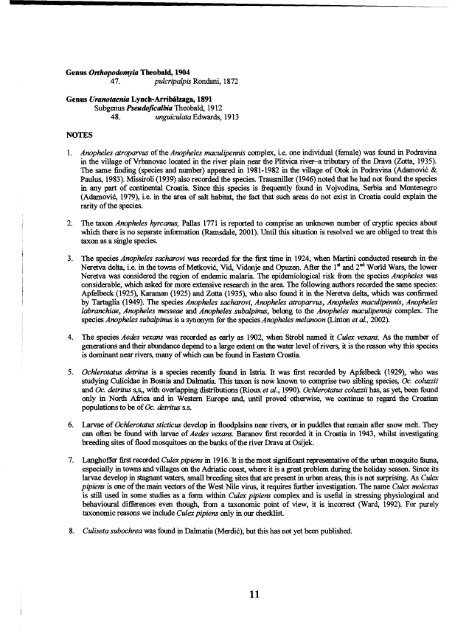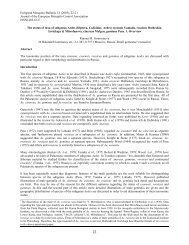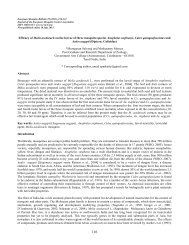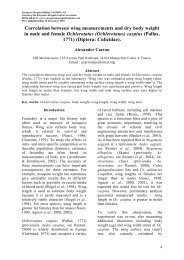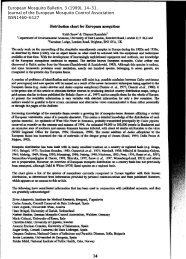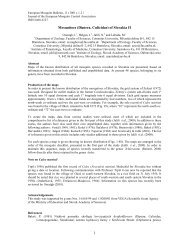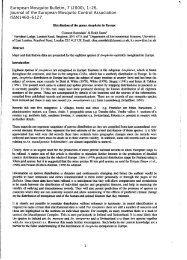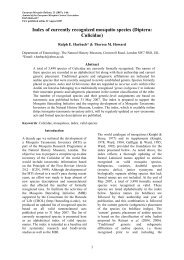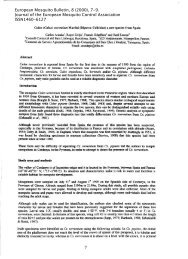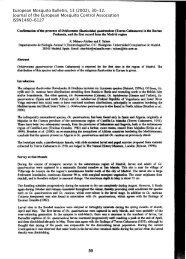Checklist of mosquitoes (Diptera, Culicidae) of Croatia - European ...
Checklist of mosquitoes (Diptera, Culicidae) of Croatia - European ...
Checklist of mosquitoes (Diptera, Culicidae) of Croatia - European ...
You also want an ePaper? Increase the reach of your titles
YUMPU automatically turns print PDFs into web optimized ePapers that Google loves.
Genus Drthopodomyia Tbeobald, 1904<br />
47. pulcripalpis Rondani, 1872<br />
Genus Uranotaenia Lyncb-Arribalzaga, 1891<br />
Subgenus Pseudojicalbia Theobald, 1912<br />
48. unguiculata Edwards, 1913<br />
NOTES<br />
1. Anopheles atroparvus <strong>of</strong> the Anopheles maculipennis complex, i.e. one individual (female) was found in Podravina<br />
in the village <strong>of</strong>Vrbanovac located in the river plainp.ear the Plitvica river-a tributary <strong>of</strong> the Drava (Zotta, 1935).<br />
The same finding (species and number) appeared in 1981-1982 in the village <strong>of</strong> Otok in Podravina (Adamovic &<br />
Paulus, 1983). Missiroli (1939) also recorded the species. Trausmiller (1946) noted that he had not found the species<br />
in any part <strong>of</strong> continental <strong>Croatia</strong>. Since this species is frequently found in V ojvodina, Serbia and Montenegro<br />
(Adamovic, 1979), i.e. in the area <strong>of</strong> salt habitat, the fact that such areas do not exist in <strong>Croatia</strong> could explain the<br />
rarity <strong>of</strong> the species.<br />
2. The taxon Anopheles hyrcanus, Pallas 1771 is reported to comprise an unknown number <strong>of</strong> cryptic species about<br />
which there is no separate information (Ramsdale, 2001). Until this situation is resolved we are obliged to treat this<br />
taxon as a single species.<br />
3. The species Anopheles sacharovi was recorded for the first time in 1924, when Martini conducted research in the<br />
Neretva delta, i.e. in the towns <strong>of</strong>Metkovic, Yid, Vidonje and Opuzen. After the 1st and 2nd World Wars, the lower<br />
Neretva was considered the region <strong>of</strong> endemic malaria. The epidemiological risk from the species Anopheles was<br />
considerable, which asked for more extensive research in the area. The following authors recorded the same species:<br />
Apfelbeck (1925), Karaman (1925) and Zotta (1935), who also found it in the Neretva delta, which was confirmed<br />
by Tartaglia (1949). The species Anopheles sacharovi, Anopheles atroparvus, Anopheles maculipennis, Anopheles<br />
labranchiae, Anopheles messeae and Anopheles subalpinus, belong to the Anopheles maculipennis complex. The<br />
species Anopheles subalpinus is a synonym for the species Anopheles melanoon (Linton et al., 2002).<br />
4. The species Aedes vexans was recorded as early as 1902, when Strobl named it Culex vexans. As the number <strong>of</strong><br />
generations and their abundance depend to a large extent on the water level <strong>of</strong> rivers, it is the reason why this species<br />
is dominant near rivers, many <strong>of</strong> which can be found in Eastern <strong>Croatia</strong>.<br />
5. Ochlerotatus detritus is a species recently found in Istria It was first recorded by Apfelbeck (1929), who was<br />
studying <strong>Culicidae</strong> in Bosnia and Dalmatia This taxon is now known to comprise two sibling species, Oc. coluzzii<br />
and Oc. detritus s,s" with overlapping distributions (Rioux et al., 1990). Ochlerotatus coluzzii has, as yet, been found<br />
only in North Africa and in Western Europe and, until proved otherwise, we continue to regard the <strong>Croatia</strong>n<br />
populations to be <strong>of</strong> Oc. detritus s.S.<br />
6. Larvae <strong>of</strong> Ochlefotatus sticticus develop in floodplains near rivers, or in puddles that remain after snow melt. They<br />
can <strong>of</strong>ten be found with larvae <strong>of</strong> Aedes vexans. Baranov first recorded it in <strong>Croatia</strong> in 1943, whilst investigating<br />
breeding sites <strong>of</strong> flood <strong>mosquitoes</strong> on the banks <strong>of</strong> the river Drava at Osijek.<br />
7. Langh<strong>of</strong>fer first recorded Culex pipiens in 1916. It is the most significant representative <strong>of</strong> the urban mosquito :fauna,<br />
especially in towns and villages on the Adriatic coast, where it is a great problem during the holiday season. Since its<br />
larvae develop in stagnant waters, small breeding sites that are present in urban areas, this is not surprising. As Culex<br />
pipiens is one <strong>of</strong> the main vectors <strong>of</strong> the West Nile virus, it requires further investigation. The name Culex molestus<br />
is still used in some studies as a form within Culex pipiens complex and is useful in stressing physiological and<br />
behavioural differences even though, from a taxonomic point <strong>of</strong> view, it is incorrect (Ward, 1992). For purely<br />
taxonomic reasons we include Culex pipiens only in our checklist.<br />
8. Culiseta subochrea was found in Dalmatia (Merdic), but this has not yet been published.<br />
11


